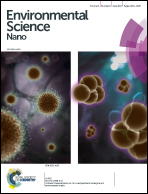Differential effect of micron- versus nanoscale III–V particulates and ionic species on the zebrafish gut†
Abstract
Manufacturing of electronic products and semiconductor wafers involves the use of III–V materials, which can lead to the shedding of particulate and ionic (e.g., arsenic) waste products that gain access to waste water streams. Of particular concern is the use of chemical mechanical planarization (CMP) for polishing of semiconductor wafers, with the potential of contributing GaAs and InAs particulates and ionic species that could adversely impact aquatic organisms. We adopted zebrafish (Danio rerio) embryos, larvae and adults as model organisms for studying the potential impact of commercially acquired GaAs and InAs particulates and ionic species in an automated screening platform. While there was no effect on zebrafish embryo hatching, morphological abnormalities or survival at particle doses up to 200 ppm (environmentally relevant), larval screening demonstrated survival reduction and inhibition of growth by nanoscale particulates (nm-InAs and nm-GaAs) and As(III). These growth inhibitory effects could be ascribed to compromised digestive function, as evidenced by enzymatic assay for digestion as well as structural damage to the gastrointestinal tract (GIT). Moreover, the damage inflicted by nm-InAs and nm-GaAs particulates could be seen to persist after a depuration period. Larvae and adult fish were used in mechanistic studies to demonstrate that GIT damage is linked to the induction of an oxidative stress response, as reflected by glutathionine (GSH) depletion and immunohistological evidence of heme oxygenase 1 (Hmox1) expression. In summary, the impact of III–V particulates and ionic species on the zebrafish GIT could serve as a study model for the adverse health outcome of semiconductor slurries in aquatic organisms such as fish.



 Please wait while we load your content...
Please wait while we load your content...